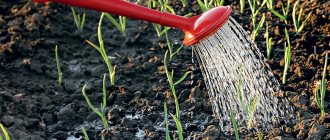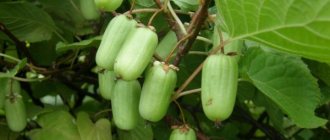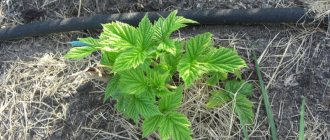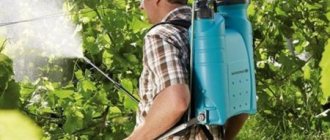When is it necessary to water indoor lemons?
The most important thing in caring for indoor lemon is soil moisture. A moisture-loving tree always needs moist soil. Drying out of the earthen coma quickly leads to the death of the plant. Therefore, a lump of earth can dry only from above and only to a depth of no more than 0.5 cm.
The lemon tree must be watered regularly and moderately, but you should not overwater the lemon, as it cannot stand stagnant water in the pot.
It is advisable to water at the same time of day. It is better to water in the late afternoon or morning. If the top layer of soil in the pot has dried out, you need to water it. But first you need to make sure that the plant really does not have enough water.
Indeed, due to poor drainage, sometimes the bottom layer of soil in the pot remains very wet, and the top one dries out. Watering in this case will soon lead to rotting of the roots. The moisture content of the soil in a pot can be determined by weight by picking it up with one hand.
If it has become significantly lighter than after watering, it is necessary to water it. When the soil is very dry, young lemon shoots droop. In this case, the lemon tree needs to be watered as soon as possible - it is on the verge of death. If you continue to dry the soil in the pot, the tree can no longer be saved.
The importance of following a watering schedule
Lemon, as one of the leaders in the domestication of citrus crops, is considered an unpretentious plant. Full development at home is possible if you comply with a small list of requirements, which determine: how often to water lemons, what to water them with, when to arrange dormant periods. Watering simultaneously performs several functions:
- helping to obtain nutrients from the soil;
- coordinating evaporation processes;
- stabilization of humidity indicators.
Its development at home depends on following the rules for watering a lemon growing in a pot. Citrus growers recommend establishing a watering schedule at the beginning of cultivation and following it throughout the existence of citrus crops in the house. Excessive irrigation can cause diseases of the root system; drought can lead to the death of the plant. Excess moisture can cause:
- rotting of the root system;
- infection with fungal diseases;
- loss of elasticity of leaves and trunk;
- yellowing, wilting of leaf blades;
- slowing down the growth process;
- preventing fruiting.
The lack of moisture in indoor plants can be easily determined by the condition of the upper layers of the soil. Dry lumps of earth begin to harden, the surface cracks. The above-ground part reacts to drought in its own way:
- the tips of the leaves dry out;
- the plant turns yellow;
- the ovaries fall off;
- trees are unable to produce and form fruits.
Regular watering errors lead to the loss of the lemon's natural defense mechanisms, making it weak and vulnerable.
How often to water lemon at home
The lemon tree is watered depending on the condition of the earthen ball in the pot. The soil should always remain slightly moist. It is necessary to water indoor lemons more often in summer than in winter. How often to water homemade lemon:
- In hot weather, water the lemon 2 or even 3 times a week. In rainy weather, watering is reduced and watered 1-2 times a week.
- In spring and autumn , when there is no heating season, water 1-2 times a week;
- During the heating season , if lemon is kept in the room, the frequency of watering is increased to 2 times a week. Heating radiators greatly dry out the air in the room, so the soil in a pot with lemon dries out faster;
- Watering lemons at home in winter, if they are kept cool, is rarely necessary. Watering at a reduced temperature is carried out once a week or less. In this case, you need to monitor the condition of the lump of earth in the pot.
After transplanting, the lemon must be watered well. After this, the normal watering regime for this plant is resumed.
Watering frequency
The frequency of watering depends on the age of the tree, the soil in which it grows, the temperature and lighting in the room, the time of year and many other factors.
Loose soil in a small pot dries out faster than a dense lump in a large container . In a room with central heating, the soil is drier than in rooms with a stove. In summer, all plants are watered more often than in winter. You should pay attention to these details when deciding whether to water the plant or wait a little.
Experienced gardeners determine the need for watering by eye. Beginners are advised to squeeze a pinch of soil from the pot with their fingers .
If the soil sticks together into a lump, it means that the time for watering has not yet come, there is enough moisture in the soil. If the soil crumbles, it’s time to water.
Interesting things on the site:
Trimming and shaping lemons at home
How to properly replant a lemon at home
Why does home-grown lemon not bloom?
The best water for irrigation
To water the lemon tree, it is better to use clean and soft water. Rainwater or melted snow is ideal for this purpose. You can water the tree with water from the river. Tap water is not very suitable for watering a lemon tree.
Various chemical compounds are added to it that harm the lemon. They cannot be completely removed from water even by prolonged settling and filtration.
Tap water can be slightly improved to make it suitable for irrigation.
To do this, it is boiled and then settled for several hours. At the same time, water loses many harmful chemical compounds that come out through the surface or are destroyed when heated. Calcium salts also precipitate and the water becomes softer.
The water for watering the lemon tree should be warm:
- In summer, its temperature should be 2-3ºС higher than the air temperature;
- In winter , when the temperature drops, water with water no colder than 25ºС.
How to water a lemon to make it bear fruit
To water the lemon, use water at room temperature, not lower than 15 °C:
- river;
- rain;
- snow;
- tap water that has undergone special treatment.
Initially, tap water is saturated with salts, hard and contains a lot of chlorine. There are several methods for softening tap water:
- 1 tablespoon of citric acid is dissolved in 10 liters and left for 24 hours;
- water is heated to 80-90 °C, left for 24 hours;
- collected, infused in the sun, and then used to water lemons;
- dissolve 4-5 drops of acetic or nitric acid in settled, unboiled water;
- 200 g of acidic peat are infused in 3 liters for 24 hours, then filtered and used for watering citrus fruits;
- The settled water is not poured to the bottom, but a bottom layer with sediment 10 cm deep is left, which is not suitable for watering lemons.
Citrus growers use hot tap water after cooling because it is less harsh than cold water.
Important! It is recommended to water in the evening, when moisture evaporates less.
How to properly water indoor lemon
Watering lemons should be done correctly at any time of the year. But it is necessary to monitor the condition of the soil especially carefully during the growing season and flowering. At this time, the tree especially needs moisture.
The lemon tree is watered from above, moistening the lump of earth using a watering can. Correctly water lemon at home in 2 stages:
- First, the top layer of soil is moistened with a small amount of water and wait until it is absorbed into the ground;
- After 5-10 minutes, begin the main watering. Water is carefully poured onto the surface of the earthen clod. It is necessary to water with a thin stream so that the soil is not washed out and the roots are not exposed. Watering ends when excess water begins to flow into the pan.
Usually a small amount of water remains in the pan. It is not drained. After a few hours, it is also absorbed into the soil from below. If the soil is very dry, it will not be possible to moisten it completely in one watering.
In this case, when the tree is watered for the first time, a large amount of water goes into the pan. It is poured into a watering can and after 20-30 minutes the tree is watered again. So in 2 waterings you can well and evenly moisten even a very dry earthen ball.
The importance of watering
- In summer, water the tree every other day, carefully monitoring the drying of the soil so that it can be moistened in a timely manner.
- The leaves of the plant must be refreshed with water from March to September.
- In winter, it is enough to water the plant once a week.
- For irrigation, you should use settled, non-cold water.
If there is a lack of moisture, the leaves may fall off, and if there is an excessive amount of moisture, the root system rots, which leads to the death of the tree. It is extremely important to water the plant deeply during flowering.
In spring, you need to water the lemon in the morning. If the air in the room is dry, then it needs to be humidified by placing a bucket of water next to it.
It is necessary to water the lemon in the morning in the spring.
The need for pruning is caused by decorative and sanitary features. Its shape and layout most often depend on the purpose of growing the tree. Small ornamental plants do not need large spreading branches, so they are pruned as much as possible, making the crown compact. For citrus fruits that bear fruit, the rule of balancing branches and shoots applies. The most common method of such pruning is pinching.
Only after the lemon has grown stronger and has produced new branches should they be pinched. 3-4 leaves remain on each branch. This pruning method allows the tree to grow strong, capable of holding and allowing them to mature fully.
It is important to prune old dead branches. Lemon spends his energy on them, but he won’t be able to revive them. Therefore, it is better to relieve the lemon of excess load. Those shoots that grow inside the crown can also be pruned. They most often prevent neighboring branches from developing and receiving sufficient sunlight.
Spraying a lemon tree
The lemon tree grows well at high air humidity of 60-70%. There are several ways to increase humidity. One of them is spraying lemon. Lemon trees are sprayed depending on the ambient temperature. In hot weather they spray more often, and in cool weather - less often:
- In summer, on clear, hot days, the air becomes especially dry, so spraying is carried out daily. You can spray lemon up to 3 times a day. In cloudy weather, spraying is carried out once a day;
- In autumn and spring you can spray 2-3 times a week. At this time of year, the air becomes more humid due to numerous precipitation, so spraying is carried out less frequently;
- During cool wintering, it is not recommended to spray lemon. At low temperatures, pathogenic fungi develop quickly, and humidity contributes to this. When it's cool, the tree needs dry air. This is achieved by regular ventilation of the room.
Fruit ripening period and harvest
How long does it take for a lemon to ripen on a tree? On average, harvesting begins 3-4 months after flowering ends. As a rule, this time falls at the beginning - mid-winter. The ripeness of fruits is determined by color and taste. If the bush bears fruit abundantly, then you can pick one fruit, cut it and taste it. If there is too much acid, you will have to wait a couple more weeks.
It is not recommended to leave a ripe lemon harvest on the tree longer than January, otherwise fruiting may be delayed next year. In addition, by this time the fruits are wrinkled, which indicates that they are overripe.
Tips for watering lemons growing outdoors
In the warm season, it is useful to take the lemon tree out into the open air. But we should not forget that watering a lemon in a garden or on an open loggia is different from watering a tree indoors.
Outdoors, the soil in a lemon pot dries out very quickly. Water evaporates several times faster than in the room. Here it is not enough to water the lemon often. You need to follow certain rules for keeping a lemon tree in a flower pot outside.
A pot for lemon growing outdoors must be made of a material that does not allow water to pass through. Is it plastic or glass. If the tree grows in a clay pot, it needs to be placed in a plastic pot. It is advisable to mulch the soil in the pot to retain moisture and prevent it from evaporating.
The following is used as mulch:
- Peat;
- Bark;
- Live moss;
- Sawdust.
A layer of mulch 2-3 cm thick is placed in a pot on the surface of the soil. Watering is carried out only in the early morning or late evening.
At this time there is no direct sunlight, the air temperature is reduced, which helps retain moisture. You need to water the lemon outdoors gradually, in small portions, so that the soil has time to be well saturated with moisture. You can use a drip irrigation system.
Varieties suitable for home cultivation
Growing a citrus tree at home is only possible if you follow certain rules for watering the plant.
Proper care is the key to a beautiful and healthy tree. Not knowing how to water a lemon can have a detrimental effect on it or cause illness.
For the health and beauty of citrus, it is important to follow the watering regime. If you follow just a few simple rules, the lemon will delight you not only with its appearance, but also with its fruits.
It is important to irrigate the lemon as needed, but the main thing is regularity. You shouldn’t leave the plant without water for a very long time, but you shouldn’t overuse it either.
The frequency of irrigation also depends on the air temperature. During warm periods of the year, the lemon tree should be watered 1-2 times a day, and in cold periods 2-3 times a week will be enough.
It is very important to follow the above rule about the frequency of watering, because the well-being of the plant depends on it.
How often is it recommended to water lemons in summer and winter, including at home? In winter, it is better to moisten the soil in the evening: overnight the plant will better replenish the water deficit. In summer, citrus is watered in the morning and evening, since the air temperature is lower, there is no scorching sun and the moisture does not have time to evaporate. In the warm season, citrus needs more moisture, so the plant is irrigated more abundantly in summer than in winter.
In spring and summer, indoor lemon can be taken out into the garden or onto the balcony. In fresh air at temperatures above 29 degrees, the plant will receive more heat and light from the sun. A citrus tree outdoors is watered with plenty of water, since moisture outside evaporates faster than at room temperature.
To understand that the plant needs to be watered, take a small handful of soil at the roots and squeeze with your fingers. If the soil crumbles, then the citrus needs water, and if it sticks together, then there is enough moisture. You can determine whether a tree needs to be watered by looking at the color of the soil: dry soil is gray.
When caring for citrus trees, special importance must be given to water, since liquid unsuitable for irrigation will kill the tree.
Under no circumstances should you moisten the soil with tap water. It contains chlorine, lime and other substances that harm the plant.
Tap water contains mineral salts that form a coating on the surface of the earth that interferes with the absorption of the elements zinc, iron and manganese.
When they are deficient, the tree begins to hurt or grows slower. If after watering the top layer of soil becomes covered with mold or a white coating, then the liquid is not suitable for citrus.
There are several options for making water suitable for irrigation:
- Sitting the water is one of the most effective methods to make water safe for lemons. Pour tap water into a wide-necked container and leave for 24 hours. During this time, chlorine and lime will leave the liquid. This way there will be no harm to the plant.
- Filtration. Pass tap water through a filter, then it will be cleaned of more impurities and harmful substances. This liquid can be used to water the plant harmlessly.
- Boiling. Boil water and cool to room temperature. This way, no harmful impurities will remain, but the amount of oxygen useful for plants will be reduced.
The ideal water temperature is 2-3 degrees above ambient temperature. But it is harmful to pour liquid over 35 degrees onto lemon.
- Adding impurities will also soften the water and kill harmful substances. You can add acetic (5-6 drops per liter), citric (0.5 grams per 3 liters) or oxalic acid (2 grams per 10 liters).
- However, the most useful is succinic acid. It not only softens the water, but also has a beneficial effect on the health of the tree, stimulates plant growth and strengthens the roots. Succinic acid is also useful for the soil: it cleanses the soil of contaminants and improves its microflora.
- Half a teaspoon of wood ash (for every liter of water) or fresh peat will also make the water suitable for irrigation. Wrap 50 grams of peat in cloth or gauze and immerse it in 5 liters of water for a day.
- Check if the plant needs watering.
- If the soil is dry, water the tree in two passes. With the first, water irrigates only the surface of the soil. To ensure that the water penetrates into the soil, water it again after a while.
- It is necessary to irrigate citrus slowly so that the water reaches all parts of the roots and soil. It is recommended to use a watering can with a long spout to better control the volume of liquid. Watering quickly will cause water to pass through the drainage holes and prevent the soil from absorbing moisture. Do not leave dry places on the entire surface of the earth.
- It is recommended to water until water begins to appear at the bottom of the pan.
- After the soil has absorbed all the moisture, drain the water from the pan to avoid stagnant water.
- Remember that lemons in the soil also receive rainwater, so don’t forget to check the soil before watering.
- Water not only near the tree trunk, but also 10-15 cm around it so that all roots receive enough water.
- Take your time. Irrigate generously but slowly so as not to overwhelm the tree's roots.
- During the hot season, avoid getting drops of water on the leaves, as moisture will cause burns under the scorching sun.
Improper watering of lemon is the most common cause of plant disease. If there is not enough moisture, the leaves of the tree will turn yellow and fall off and the lemon will wither. Lack of moisture will kill the plant.
Too much water is also dangerous. From a large amount of liquid, the earth turns sour and the roots begin to rot. Therefore, it is very important to follow the rules and watering regime. The health and appearance of the tree depends on this.
Subtropics are a familiar environment for citrus fruits. Therefore, they are accustomed to high humidity. Air humidity is very important for citrus fruits, so it is important to constantly spray the tree.
When spraying, not only the plant itself is moistened, but also the air around it, creating comfortable conditions for citrus. Spraying is necessary to clean the leaves and trunk of the tree from accumulated dust. Regular spraying protects the plant from parasites living in dry environments.
Use a spray bottle to distribute the moisture evenly throughout all the leaves of the tree. Do not spray the tree in direct sunlight, as moisture droplets will cause burns. Therefore, you should spray lemon in the morning or evening.
It is not difficult to follow all the rules for watering citrus, the main thing is regularity. If you water a lemon correctly, it will not only be healthy, but also beautiful to look at. Remember that it’s easy to start a plant and destroy it, but bringing it back to life is difficult and sometimes impossible.
Watering is the main component of lemon health. To care for a lemon correctly, monitor the condition of not only the tree and fruit itself, but also the soil, since the successful growth of citrus depends on the soil.
source
All citrus growers know that growing lemon at home is possible only if the plant is properly cared for. It is necessary to follow the rules of watering so that the tree can please its owner for a long time with beautiful leaves, as well as flowers and fruits that will be no different from those purchased.
Proper watering is important for lemon fruiting.
For proper watering, it is important not only how often the plant is watered, but also what kind of water is used. After all, not every liquid substance is beneficial for the plant, and some can lead to disease or even death of the tree.
Read more: What to feed little rabbits: diet
Water carries various salts, minerals and other substances that can be both beneficial and harmful to lemons. That is why, in order to successfully grow citrus fruits, you should carefully and responsibly approach the choice of liquid for irrigation.
According to experts and researchers, it is best to use river, rain or snow water. However, most people growing this tree have the option of using only tap water.
Tap water is not the best option for caring for lemons due to the chlorine content and other substances that are used to disinfect the liquid. However, there are still several ways to bring water from pipes to a state where its use will not harm the citrus plant.
Tap water is dangerous for lemon trees due to its high levels of lime and other mineral salts. Constantly watering or irrigating the plant with such water will lead to the formation of salt deposits and the appearance of diseases in the tree, due to which it will begin to wither or die altogether. This is another aspect that indicates that the liquid from the pipes must be cleaned before watering the plants with it.
Tap water is purified as follows:
- The container with water is heated, and then kept in the open air for at least 24 hours, continuing to heat.
- The liquid is left in the sun, after pouring it into a container with a wide neck, and kept in this place for 24 hours.
- The water is boiled and then allowed to settle.
- Water from the tap is settled without preliminary boiling. When the water has settled, citric acid is added to it at the rate of one gram of the substance per 6 liters of liquid, as well as acetic or nitric acid in the proportion of 4-5 drops of acid per liter of water.
- About 200 grams of high-moor peat are infused in three liters of water for 24 hours.
If you purify tap water using one of these methods, you can use it to water your homemade lemon. Experienced citrus growers say that hot water from a tap, cooled to a level of 30–35 degrees Celsius, can also be suitable for watering citrus trees, since its hardness is quite close to boiled water.
Clean river water is the best option for watering lemons
Now there is no single answer to the question of how often to water a lemon, since this process is affected by the age of the tree, humidity level, temperature, soil in the pot and much more. You should focus on the condition of your own lemon tree.
For example, loose soil placed in a small pot dries out faster than a dense ball of earth in large pots. This means that in the first case you need to water more often than in the second. A plant that is located in a room with central heating will have to be watered more intensively, since it greatly dries out the air in the room.
Replanting a lemon tree is a troublesome task.
Symptoms of overwatering a plant
The lemon tree does not tolerate stagnation of water in the pot. Its roots require not only water, but also air. When moisture accumulates in the soil, the root system becomes deprived of air and dies. Dead areas of roots in wet soil rot very quickly, providing favorable conditions for the development and spread of fungal infection.
When overwatered, lemon does not show any symptoms for a long time. The tree grows well, and overflow is indicated only by the condition of the soil in the pot:
- The surface of the earth becomes moldy;
- The soil does not dry well;
- In a pot of lemon, insects and a characteristic mushroom smell appear.
At this time, you can still save the plant. It is necessary to reduce watering and move the lemon to a ventilated room. If these measures do not produce results, you need to replant the tree in new soil, replacing the drainage and checking the drainage holes.
If a lemon sits in waterlogged soil for a long time, its roots can be severely damaged.
They stop working, which immediately affects the leaves of the plant. When overwatered, lemon leaves begin to turn yellow from the petiole to the leaf blade. Then they die and fall off.
Unfortunately, yellowing of lemon leaves means its imminent death.
But you can still try to replant the tree. It should be remembered that lemon leaves turn yellow if the roots are severely damaged. It is extremely rare to save a tree in such cases.
Diseases of homemade lemon
What diseases of lemon tree exist? Caring for this attractive plant at home also involves healing it. Very often, illnesses occur due to infrequent or too frequent watering of the tree. If the lemon foliage is covered with yellow spots, and then begins to dry out and turn pale, then the plant most likely lacks iron.
If the tips of the leaves dry out and they themselves seem to rust, this indicates a lack of phosphorus. A lack of potassium leads to corrugated leaves, and with a lack of manganese, the ovaries fall off.
Prevention of the negative manifestations described above lies in timely and competent fertilization of lemon.
Weakened plants are the first to enter the risk zone. They are the ones most often exposed to illnesses. If the tree is sick, then damaged branches, fruits, leaves, and flowers must be removed. If you find a pest, treat it immediately.
The product “Fitosporin” shows excellent results. It suppresses an impressive range of pathogens that cause citrus diseases. This product does not contain toxic compounds and is odorless. "Fitosporin" is used for spraying. The powder should be diluted in water according to the instructions on the package. This drug is suitable for the prevention of illnesses. Fitosporin has no waiting period.
The most common diseases of lemon trees are:
- Wart or scab is a fungus that appears on young leaves and shoots. First, pale yellow spots appear, which then transform into gray warts. The growths grow into shoots, which die later. Scab also affects fruits. Bright yellow spots appear on them, which then darken and turn red. All damaged areas of the plant must be cut off and destroyed, and the crown and trunk must be treated with 1% Bordeaux mixture (a mixture of milk of lime and copper sulfate solution).
- Anthracnose is the most common fungal disease that causes yellow leaves of homemade lemons. With this disease, buds fall from the tree, branches die, and brown spots appear on the fruit. All fruits and damaged shoots must be removed and the tree treated with Bordeaux mixture or Fitosporin.
- Sooty fungus is a consequence of infection by scale insects or mealybugs. Active prevention is the surest way to protect the tree from such consequences.
- Gommosis - manifested by the appearance of dark red spots on the branches and trunk. In damaged areas, the bark cracks, gum (sticky liquid) flows out of the cracks, which then hardens. This disease can appear for various reasons, such as improper care, contaminated soil, improper burial of seedlings, and mechanical damage to the plant. To begin treatment, you first need to find out the cause of the disease in order to rule it out and prevent relapse. Next, you need to cut out the affected areas with a sharp knife and treat them with a 3% solution of copper sulfate. It is advisable to cover wounds on branches and trunk with garden varnish.
Inspect your citrus perennial regularly, because this way you can notice the disease at its very beginning.
What to do if your lemon tree is overwatered
When overwatering, if the condition of the lemon is satisfactory, you can try to save it without an emergency transplant. To do this, you need to quickly dry the earthen ball so that it becomes slightly damp. You can get rid of excess water as follows:
- Enlarge the drainage holes with a sharp knitting needle or knife; in case of stagnation, excess water can immediately flow into the pan;
- Loosen the top layer of soil in the pot;
- The bulk of the earthen coma must be pierced in several places with a sharp and thick knitting needle so that air penetrates into the soil;
- Move the plant to a warmer and regularly ventilated room to dry the soil as quickly as possible.
If a lemon is rapidly losing its leaves and its top has wilted, an emergency replanting will be required with soil replacement and root inspection. The plant is removed from the pot, the old soil is removed and the roots are examined.
If there are rotten areas, but some of the roots look healthy, you can try to revive the plant.
All diseased parts of the roots are cut off, and the sections are sprinkled with crushed activated carbon. The drainage in the pot is changed and the drainage holes are cleaned. The plant is planted in new soil. The transplanted lemon is placed in partial shade until growth begins.
How to grow from seed
How to care for tiny sprouts at home? Flowering of a lemon tree grown from a seed can be observed only a few years after planting and emergence of seedlings.
Lemons grown indoors have a more intense flavor. One of the basic stages is the selection of first-quality seeds. This is the key to successfully growing a tree. You need to place several seeds in the soil so that you can select the strongest shoots. The process consists of the following stages:
- Remove seeds from large ripe citrus fruits, select the largest ones.
- Planting material can be placed in the ground immediately, but some gardeners advise treating it with a solution of sodium hummate in advance. To do this, dilute the substance with water as indicated in the instructions. Immerse lemon seeds in it for a day.
- Place drainage (expanded clay, tiny pebbles or charcoal) at the bottom of the pots and lay soil on top. The soil for homemade lemon should consist of equal parts of flower soil and peat. You can also buy a ready-made mixture for citrus plants. Lemons feel great in leaf humus mixed with black soil (1:1). You can also add a little sand there.
- Bury the seeds into the ground by 1 cm. The distance between them should be at least 5 cm. You need to retreat about 3 cm from the sides of the pot.
- The soil should always be moist, but not oversaturated with water. The ideal temperature for seedlings is in the range from +18 to +23 degrees Celsius.
- In a couple of weeks, the first shoots will appear from the seeds. From the very beginning you will see the strongest specimens. Select them for further germination.
- In order for a homemade lemon to start growing, you need to create an appropriate climate for it. To do this, cover the sprouted sprouts with glass jars and then send them to a well-lit place. However, try to avoid direct sunlight.
- Ventilate the sprouts every day. To do this, remove the jars from them for 20 minutes.
- When two or three full leaves appear, transplant the lemons into separate containers. The pot for the sprout should have a diameter of no more than 10 cm. Drainage at the bottom is a prerequisite.
- In its first pot, the young seedling from the seed should grow to 17-20 cm in height. After this, it should be transplanted into a larger container.
“Warm” wintering of citrus fruits
Unfortunately, not all citrus growers can provide the plant with the correct conditions for a cold winter, so most often they try to provide indoor trees with conditions under which they would continue to grow, but they do this not so actively.
Air temperature and lighting. Just as in the case of “warm” wintering, the owner of the premises is faced with the task of ensuring uniform heating of the plant over its entire height. As we remember, it is the imbalance of temperatures in the upper and lower parts of the plant that leads to the fact that it begins to shed its leaves.
The optimal air temperature for a “warm” wintering of citrus fruits is 18-20°C.
Organizing the correct conditions for keeping citrus plants in an apartment with central heating is not so easy. It is doubly difficult to organize the care of indoor crops in conditions of uninsulated windows. In such a situation, a kumquat, calamondin or any other citrus tree wintering on a windowsill runs the risk of encountering a sharp temperature change when the roots of the plant suffer from drafts and cold transmitted from the windowsill. At the same time, the side of the tree that faces the room (especially its upper part) may swelter from the heat.
If you want to simplify your task of caring for a citrus plant in winter, prepare for wintering in advance:
- insulate the window frames on which the pot with a tree or bush will stand;
- Contact the authorized authorities and clarify the question of whether it is possible to install a thermostat on the battery located under the “citrus window”. If yes, spare no expense on materials and professional work to install the thermostat.
Regardless of which window your green pet will stand on, it will still have to be illuminated in winter. Ideally, daylight hours for citrus fruits in winter should be about 12 hours. In this case, it is necessary to ensure that the leaves of the plants are not damaged by direct sunlight. Pay close attention to this issue from the end of February to the beginning of March, when the sun is especially active.
- How, when and how much to add light to seedlings and is it necessary at all?
Is purchasing specialized phytolamps an important matter or a waste of money?
Watering and humidity indicators. To prevent the plant from being damaged by the warm and dry air that rises from the central heating radiator, you will have to equip it with a protective screen. At the same time, you will need to think about a system that would help maintain optimal humidity levels. For a temperature of 18-20°C - this is 40-50% (no less!).
The higher the temperature in the room, the higher the humidity on the windowsill should be. At levels above 20-22°C, it should be at least 60-70%.
In winter, the plant needs spraying much more than watering, so if possible, try to spray the plant at least once a day (water characteristics are the same as with regular watering). Be sure to monitor humidity levels and, if necessary, take measures to increase it, for example, place a wide container of water near the plant or purchase a humidifier.
- Building a “solar” box for seedlings - step-by-step master class
You can buy a box for seedlings, or you can make it yourself - not just a simple one, but a special one!
How often should you spray lemon?
For these plants, air humidity in the room is important because their usual habitat is subtropics. Homemade lemons should be sprayed daily with soft water. In this case, not only the leaves of the plant are moistened, but also the air around it.
Spraying saturates the air with moisture and at the same time cleans the foliage and stem of dust. Constant spraying promotes the growth and development of indoor lemons and fights spider mites, which love dry air.
What fertilizers are suitable
When planting or replanting a lemon tree, the fertilizers applied to the ground will last only 3–4 months. Therefore, when this period ends, you need to add fertilizer to the pot. In this case, mineral fertilizers are used.
It should be noted that often not completely rotted manure is added to the soil mixture for citrus fruits. The bacteria living in it use nitrogen in their life. Therefore, in this case, the application of nitrogen-containing fertilizers should be increased. This rule is mandatory.
You can use horse manure. It is mixed with the prepared soil mixture in a ratio of 1:3. This feeding should be enough for about 6 months. You can also use complex fertilizers to ensure the planting blooms well. They contain phosphorus, potassium and nitrogen. They feed the lemon twice within one month.
There are certain nuances regarding the use of potassium permanganate as a top dressing. A pink solution is prepared from potassium permanganate, which is used to water the soil in the pot overnight. This is due to the fact that light leads to the rapid decomposition of potassium permanganate. As a result, watering during daylight hours will be ineffective, because the solution will not have time to penetrate the root system of the plant.
Every month the lemon tree is watered with a solution of iron sulfate. To prepare the solution, you need to take 2 g of iron sulfate and dissolve it in 1 liter of water. In a situation where leaf chlorosis is observed, the solution is prepared more concentrated: 40 g of the substance is taken per 1 liter of water.
Separate feeding of citrus fruits, carried out using the fertilizers listed above, is carried out only by experienced gardeners. Beginning citrus growers can confuse the concentration, thereby destroying the plant. Therefore, experts recommend using special complex fertilizers sold for lemons in flower shops.
Features of growing lemon indoors
When growing lemon indoors, several conditions must be observed. Lighting should be diffused. All citrus fruits do not like changes in lighting. You cannot sharply turn or move the plant from one place to another.
Flowers and ovaries begin to fall off as soon as the lighting changes. In winter, the tree can be illuminated. When kept in a room with a temperature of +7 to + 14 degrees, the backlight does not need to be turned on, because citrus fruits “fall asleep” at this temperature, do not grow, and do not need additional lighting.
The temperature in the room where the lemon grows must be constant. The plant does not like sudden changes. When ventilating a room in winter, you need to be especially careful. Cold air from the window has a negative effect on the plant, and it can drop all its leaves.
To humidify the air in winter, place a wide-necked container filled with water next to the plant.
This will keep the foliage from drying out at the edges. But we should talk about watering in more detail.
Caring for an indoor tree
Lemon can bloom and bear fruit in the 2-3rd year. Caring for indoor lemon is:
- timely watering;
- regular spraying;
- competent feeding.
Once a month, after watering, add a dose of nitrogen fertilizer dissolved in water (urea or ammonium nitrate - 2 g per 1 liter of water) into the soil. This is especially true for soil poor in organic matter. Nitrogen gives strength to plants; during spring and summer, a powerful leaf apparatus is formed, with which the tree safely endures all the hardships of winter. You can water with diluted slurry of low concentration (1:30).
Under no circumstances should you fertilize with microelements. Unlike other plants, lemons do not have hairs on their roots. Their role is played by mycorrhizal fungi. They seem to stick to the roots of the lemon, and through them the whole plant is fed. Mycorrhizae themselves feed on organic matter, for example, humus. They decompose it, forming valuable substances, which they first feed on themselves, and then feed the lemon.
Starting from the second year, in addition to nitrogen, phosphorus and potassium must be used. Superphosphate can be sprinkled on top of the soil and it will slowly but surely feed the plant. Phosphorus promotes abundant flowering and fruiting. The flowering period of the lemon tree is spring, autumn. Single buds appear throughout the year.
Fruiting period: after flowering, a fruit is formed that will grow and gain strength for 9 months. This can happen at any time. After harvesting in the spring, it is necessary to feed with urea (or saltpeter) and superphosphate. If the crop is harvested in the fall, you cannot feed it, since the plant goes dormant and excess nutrition will only weaken it. Postpone fertilizing to February.
Pigeon droppings are considered the best fertilizer among lemon growers.
Fertilizers are an important aspect in the life of indoor lemons. The root system of such plants is 30-40 times smaller in volume than those growing in open ground. But this fact does not mean at all that container citrus fruits should be intensively fed. The timing of application and the amount of nutrients depend on the condition of the plants, time of year, size of the container, etc.
The plant itself will tell you when to feed it. The growth of shoots, the color of the leaves, the size and color of the fruits are the main signs that indicate the time for feeding.
The cause of yellowing leaves is a lack of nitrogen. In addition, its shortage reduces the yield and its quality. If the plant does not have enough phosphorus, then it comes out in the form of pale and falling leaves, rough and ugly fruits. Potassium starvation is fraught for lemon with an increase in the size of leaves and their curling, a decrease in yield and fruit size.
With a lack of iron, plants may develop chlorosis, the fruits turn pale, and the tops of the branches dry out. Calcium deficiency causes general malaise - the leaves do not grow, the upper ends become stained and fall off prematurely, and the shoots die. Trees also look bad because they lack magnesium, copper, boron, zinc and other trace elements.
Among nitrogen-containing fertilizers, ammonium nitrate is most often used mixed with potassium salt in the form of a solution - 50 g of nitrate and 20 g of potassium salt are taken per 10 liters of water. If the soil is alkaline, then ammonium sulfate is used instead of nitrate - 75 g per 10 liters of water. Since phosphorus fertilizers do not dissolve well in cold water, you can dilute 50 g of superphosphate in 1 liter of boiling water and then pour the solution into a bucket of cold water.
Potassium permanganate is useful for window lemons as a good growth stimulator. To do this, 120 mg of this fertilizer is diluted in 1 liter of water, and then this solution is diluted again in about 2 liters of water. Plants should be watered with this solution once a month, or even better once every 45-50 days. Another such accelerator is feeding with a weak (2 g per 1 liter of water) solution of ferrous sulfate. In winter, fertilizers are not used.
for 1 liter of liquid 10-15 liters of water, chicken: for 1 liter of liquid 15-20 liters of water. For 1 liter of diluted cow "kaka" give 3g of superphosphate and 2g of potassium salt, and for chicken "kaka" take 2g of superphosphate and 2g of potassium salt. They have another secret - watering plants with blood water (water in which they washed meat or water in which animal blood was dripped).
You need to know how to properly care for your homemade lemon so that it pleases you not only with its decorative qualities, but also with its healthy fruits. The plant must be fertilized on time, irrigated and pruned correctly, and also replanted from time to time.
Lighting
Uniform lighting is recommended for growing lemon. It is difficult to provide it in a residential apartment, so experienced florists recommend turning the plant pot daily. For normal development of citrus fruits, a 12-hour daylight hours is ideal. In winter, it is better to artificially put the tree into a dormant state.
It can be difficult to create ideal conditions for growing lemons in an apartment. A constant air temperature is important to them, since the plant reacts very painfully to changes. During the growing season, this indicator is maintained at 22-24 °C, and during fruit ripening - about 18 °C. Lemons overwinter at 10 °C. As for humidity, in the warm season its level should not fall below 60%, and in the cold season - below 40%.
How often do you water citrus trees in the summer? Lemons need regular watering. The formation of a dry earthen lump in the upper part of the pot is unacceptable. In hot weather, daily irrigation may be required. Tap water containing a lot of chlorine should not be used to irrigate citrus plants.
The lemon is irrigated until water flows from the bottom holes of the pot. Excess liquid is simply drained from the pan. The foliage is sprayed with a spray bottle a couple of times a day.
Crown formation
Lemon trees are pruned mainly in the spring, although this work can be carried out in the fall and winter. Forming the crown is a necessary measure, since a thickened tree needs more daylight and also bears scanty fruit. The seedling is pruned for the first time when it reaches a height of 20 cm. Initially, the main trunk of the tree is pruned at a height of 30 cm.
Branches of the 1st and 2nd orders are pruned at a height of 25 cm, 3rd - 15 cm, 4th - 10 cm. Subsequent orders are not pruned at all. Those shoots that interfere with the growth of young branches must be completely removed.
Transfer
Lemon must be replanted in the following cases:
- the plant grew and became cramped in the old container;
- signs of root rot were detected;
- the pot accidentally broke;
- the tree stopped actively growing and bearing fruit abundantly.
The transplant procedure itself is similar to landing. The transshipment is carried out together with a lump of earth, while carefully examining the condition of the root system of the lemon tree. If an unpleasant putrid odor emanates from it, or other signs of root rot are noticed, then all damaged roots are immediately removed.
Fertilizers
How to feed lemons to activate growth processes and speed up fruiting? A complex fertilizer would be a suitable option, but it must be used as carefully as possible and strictly follow the instructions and recommendations. Otherwise, an overdose will occur, and instead of the desired result of healing, the plant will begin to wither, get sick, or even disappear altogether.
Circumcision
From this video you will learn how and what to feed homemade lemon and tangerine.
Tags: indoor, lemon, lemons, spraying, watering
About the author: admin4ik
« Previous entry
Fertilizer methods
The procedure for applying fertilizer for citrus fruits at home follows the same principle as in the garden. The only thing to consider here is that indoor specimens have a less developed root system. Therefore, fertilizers are added to the pot in small portions, but quite often.
Each variety of lemon has its own specific standards for fertilizing. However, here you should know the individual characteristics of the plant, since overfeeding can cause no less harm than a deficiency of nutrients. In both cases, fruiting becomes impossible.
There are the following rules for applying fertilizers to a lemon tree:
- between March and mid-August this procedure is carried out every week;
- in March, it is recommended to add slurry (100 g) and superphosphate (5 g) to the pot;
- in April, potassium sulfate (3 g) should be added to the substances used in March;
- in May, due to a decrease in the plant’s need for nitrogen, urea (1.5 g) is added to the pot, as well as complex mixtures containing boron, magnesium and copper;
- in June and July, potassium sulfate (3 g) and superphosphate (5 g) must be added to the solutions used in May;
- in August, slurry (100 g) should be added to the soil, into which manganese (0.2 g), complex mixtures and substances that were used in June should be added;
- in September only complex mixtures are taken.
In spring, summer and autumn, nutrients enter the plant through the root system, since fertilizing is applied only to the soil.
In winter, fertilizers are used once every month. At this time, only foliar feeding is carried out. In the cold season, lemon leaves should be sprayed with a solution of potassium permanganate from a spray bottle. Also, for the purpose of prevention, the tree itself is sprayed with a solution of potassium permanganate. All manipulations with potassium permanganate are carried out only in the evening.
For lemon, spraying the crown is very important. This procedure combines well with foliar fertilizing and is carried out once per month. The following drugs are used to carry it out:
- copper sulfate (250 mg/l);
- boric acid (200 mg/l);
- potassium permanganate (250 mg/l);
- iron sulfate (3 mg/l);
- zinc oxide (6 g/l);
- magnesium sulfane (10 g/l).
As you can see, fertilizing carried out for lemon at home is very diverse. Here you can use both purchased ready-made mixtures and folk remedies that you prepare yourself. The main thing is to correctly observe the timing of the introduction of nutrients, as well as their dosage. If the lemon tree does not lack macro- and microelements, then in your house it will actively bear fruit and delight the eye with its decorative appearance.
We invite you to familiarize yourself with: Stachys woolly: tubers, planting and care, cultivation











